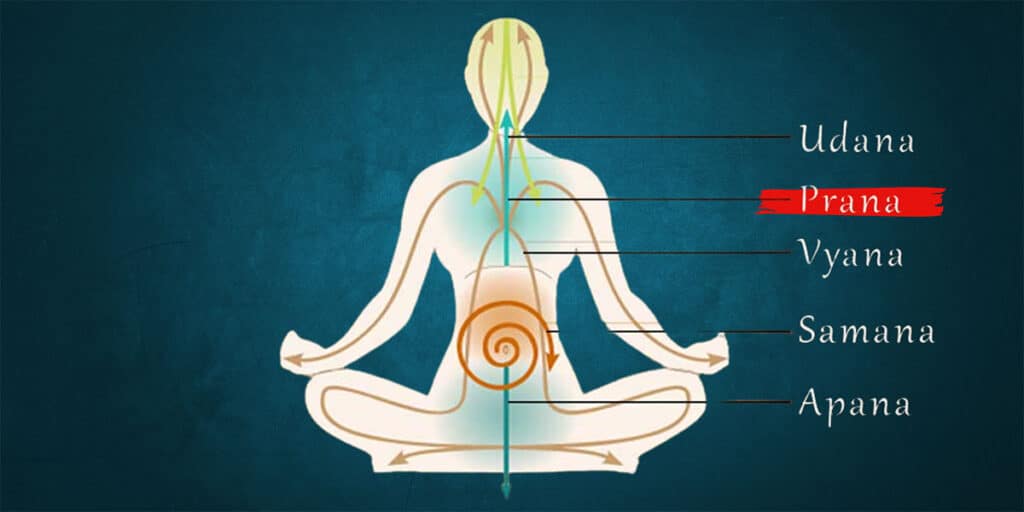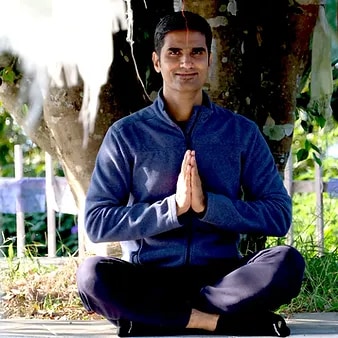Understanding Vāyu – The First of the Pancha Pranas
by Hardik Mehta

When we talk about the essence of life in yogic and Ayurvedic philosophy, the term Prana often comes up. Prana is the life-force energy that sustains all living beings. It flows through subtle channels (nadis) and concentrates in energy centres (chakras), playing a vital role in our physical, mental, and spiritual well-being.
Prana is categorised into five main life forces known as the Pancha Pranas, each playing a vital role in sustaining and regulating our energetic and physical systems. These are:
- Prāna Vāyu
- Apāna Vāyu
- Samāna Vāyu
- Udāna Vāyu
- Vyāna Vāyu
In this blog, we will explore Vāyu, specifically Prāna Vāyu – the first and most fundamental among the Pancha Pranas. Understanding this Vāyu can help us enhance our health, deepen our yoga practice, and develop a closer connection to our inner self.
What is Prāna Vāyu?
The Sanskrit word Vāyu means “air” or “wind,” and it also signifies movement or flow. Prāna Vāyu is the inward and upward-flowing life force that regulates breathing in, sensory awareness, and the assimilation of nourishment on all levels—bodily, emotional, and spiritual. It primarily operates in the areas of the head, lungs, and chest, with its energetic centre anchored at the heart (Anahata Chakra). This Vāyu draws energy into the body, supporting respiration, sensory input, and mental clarity.
The Role of Prāna Vāyu in the Body
Prāna Vāyu is responsible for:
- Breathing and oxygen intake
- Beating of the heart
- Functioning of the lungs and diaphragm
- Perception through the five senses
- Cognitive functions like attention, focus, and clarity
- Distribution of Prana to other Vayus
- Awareness and consciousness
In simple terms, it’s the energy that pulls life into us – the very first breath of a newborn and every breath thereafter until our last.
Prāna Vāyu in Yogic Philosophy
As described in ancient yogic scriptures such as the Hatha Yoga Pradipika and the Upanishads, Prāna Vāyu is regarded as the force that transports and sustains consciousness within the body. It not only supports physiological functions but is also considered a spiritual force.
- In Pranayama (breath control), the aim is to regulate Prāna Vāyu and channel it throughout the body.
- In Meditation, focusing on the breath or the chest centre helps quiet the mind and bring awareness inward.
- In Kundalini Yoga, Prāna Vāyu is seen as the driving life force that activates the latent spiritual energy at the base of the spine, guiding it upward through the chakra system.
Connection Between Prāna Vāyu and the Breath
One of the most accessible ways to understand Prāna Vāyu is through breath awareness.
Every inhalation is an opportunity to absorb fresh energy and oxygen. If our breath is shallow or erratic, Prāna becomes depleted, leading to fatigue, anxiety, and lack of focus.
Conversely, slow and steady breathing amplifies Prāna Vāyu, revitalises the entire being, and brings a harmonious balance between the body and mind.
Signs of Balanced Prāna Vāyu
When Prāna Vāyu is functioning optimally, you may notice:
- Steady and calm breath
- Clear mental focus
- Good sensory perception
- Emotional resilience
- An immersive engagement with the present
- Physical vitality and enthusiasm
Signs of Imbalanced Prāna Vāyu
An imbalance or blockage in Prāna Vāyu can manifest as:
- Breathlessness or shallow breathing
- Anxiety or panic attacks
- Poor concentration or mental fog
- Heart palpitations
- Insomnia
- Weak immunity or frequent fatigue
Such imbalances can be triggered by stress, poor posture, unhealthy diet, or lack of mindfulness.
How to Balance and Strengthen Prāna Vāyu
The good news is that Prāna Vāyu can be consciously regulated and enhanced. Here are effective yogic practices and lifestyle changes to nourish this vital energy:
- Pranayama (Breath Control)
Breathing techniques are the most direct way to influence Prāna Vāyu.
- Nadi Shodhana (Alternate Nostril Breathing) – harmonises the energy channels, stabilises pranic flow, and promotes mental tranquillity.
- Dirgha Pranayama (Three-Part Breath) – enhances lung capacity through full yogic breathing, encouraging deeper, more conscious respiration.
- Ujjayi Pranayama – creates heat and draws awareness inward.
Regular practice of these pranayamas enhances oxygenation, mental clarity, and energy levels.
- Asanas (Yoga Postures)
Certain yoga poses open the chest, enhance lung capacity, and support heart health – all of which improve Prāna Vāyu flow.
Recommended postures:
- Bhujangasana (Cobra Pose)
- Matsyasana (Fish Pose)
- Setu Bandhasana (Bridge Pose)
- Ustrasana (Camel Pose)
- Tadasana (Mountain Pose)
- Meditation and Breath Awareness
Spending 5–10 minutes daily observing the natural breath without judgment can help you reconnect with Prāna Vāyu. This practice strengthens awareness and brings stillness to the mind.
- Sattvic Diet
Eating fresh, plant-based, seasonal food nourishes the physical and energetic body. Include:
- Fresh fruits and vegetables
- Whole grains
- Herbal teas (like tulsi, ginger, or mint)
- Warm water with lemon in the morning
Avoid excessive caffeine, processed food, and cold, heavy meals that can block the flow of Prana.
- Positive Lifestyle and Environment
Since Prāna Vāyu is sensitive to external influences, surrounding yourself with:
- Clean air and natural light
- Uplifting music or chants
- Loving relationships
- Nature and greenery
…can all positively impact your energy.
Spiritual Dimension of Prāna Vāyu
Beyond its role in bodily functions, Prāna Vāyu serves as a vital link connecting the physical form with the mind and uniting external experiences with inner awareness.
It is said in yogic texts that when Prana is calm, the mind becomes still. This inner stillness opens the doorway to higher states of awareness and ultimately to spiritual awakening.
In many meditation traditions, observing the flow of breath is the first step toward transcending the ego and experiencing the Self.
Final Thoughts
Vāyu, especially Prāna Vāyu, is not just a breath but a powerful force that animates life. It governs vital functions, influences thoughts and emotions, and holds the potential for spiritual elevation.
In our fast-paced, tech-driven lives, reconnecting with our breath – and thereby with Prāna Vāyu – can be a simple yet profound act of healing.
Whether you are a seasoned yogi or a beginner on the path, tuning into your breath, practising pranayama, and living mindfully can awaken the dormant energy within and align you with your highest self.
About the Author

Hardik Mehta
Hardik is an E-RYT 500 & YACEP (Yoga Alliance Continuing Education Provider), Yoga Alliance, USA. He has been practicing yoga for the last 9 years. Prior to finding his true calling in Yoga, he was working with various corporates for 12 years in the Retail and eCommerce sector.
